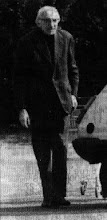The negativity of Olson’s hell is not that of Dante, despite references to the Inferno, nor that of Eliot, for whom any such negativity is assimilated to the transcendental condition of the symbolist poem. Olson’s hell is psychological, and what traps him is not eternal fire but guilt, guilt about sex, adulterous sex. In Part I, section 3, ‘the same each act’ carries an aural suggestion of ejaculation, while ‘fix’ carries a navigational sense and a colloquial one, ‘look at the fix I’m in’. It is this shifting and uncertain ‘fix’ that for the poet is to fix his identity: ‘Who am I but by a fix?’, he writes, a notion that is immediately run together with the fixing of particles, which notoriously become waves once they are observed. The lines immediately following, lines that begin ‘as in this thicket’, depend crucially on a play between body and thicket, ‘roots lie, on the surface, as nerves are laid open’, with a sudden inserted (bracketed) reference to ‘her’, ‘(the bitterness of the taste of her)’, which serves to evoke possibilities the poem takes no further. One should note in this connection, however, that ‘pincer’, two lines lower down, is an allusion to Mellors’ description of his wife’s vagina in Lady Chatterley’s Lover. The vagina dentata is to be identified, it would seem, with the displaced and isolated ‘this’ of
this
is the abstract, this
is the cold doing, this
is the almost impossible (D,29)
The phrase ‘cold doing’ is as insistent in its refusal of enjoyment, jouissance, as is the pattern of repeated assertion. It is repetition and assertion, in the highly self-conscious mode of their presentation here, that constitute what Olson calls, in the penultimate line of this section, ‘traceries’, something that leads me to think that the style of the poem is itself meant to be seen as a series of ‘fixes’, which fixes are all that remains of ritual acts once performed by the shaman. To these possibilities of meaning one can also add the use of ‘fix’ in the context of drug use, as in a drug ‘fix’. By this time, of course, ‘fix’ has also acquired a further sense, that of remedial action, though, equally, one can hardly fail to be reminded of Prufrock’s ‘eyes that fix you in a formulated phrase’, particularly when one moves on to Part II of the poem. Here, the psychological thrust of the poem is made explicit, especially in section 1, and hell becomes identified with the inner self (what Olson calls ‘your core’), and the poet’s entrapment in it. (Again, one may remember that Eliot’s rejoinder to Sartre’s pronouncement ‘hell is other people’ was ‘hell is myself’.) Hell, for Olson, is described as ‘the coat of your own self, the beasts/emblazoned on it’ (D,30), one effect of which is to establish metaphor as the reigning rhetorical figure of the text, around which the poem is organised and to which it continues to return (despite Olson’s vigorous disclaimers to Robin Blackburn on the matter). Thus, the act of sex, where ‘the beasts are met’, and where ‘she who is separate from you, is not separate’, is equated with ‘the making of one hell’. The lines that effect the equation constitute, in the metaphoric conjuncture they themselves set up, a commentary on just those figures they are in the process of employing. This self-conscious, self-referring use of metaphor is a characteristic strategy of much of the poem. Again, one finds underpinning the lengthy final paragraph of this section, comprised of repeated insistences, a metre whose iambic feet work to reinforce, by a pun, ‘why/his feet are held’. Olson prepares the way for this with a knowing reference to his own formal structure: ‘(this is why he of whom we speak does not move, why/he stands so awkward where he is’, where the promise implicit in the use of an open bracket appears to conflict with the iambic ordering of the subsequent phrases. Here, and elsewhere in his work, Olson undertakes a foregrounding of formal structure that can leave little doubt that, for him, palpable enactment is the foundation, the essential condition, of poetic meaning. Thus metrical and syntactic repletion work together on this occasion to create an almost physical sense of being fixed, as though Olson were, like Prufrock, ‘formulated, sprawling on a pin’. To posit any such similarity is not, however, to seek to obscure the many differences between the modes of enunciation and subject positioning evident in these two poems: whereas Prufrock, as subject, is in and of the poem, an effect of a certain procedure of writing, Olson is present in propria persona. ‘In Cold Hell’ emerges out of a lengthy correspondence addressed to Frances Boldereff, to whom the poem is also addressed, a context that renders problematic the relation between the epistolary and poetic personae. How far should they be identified, how far separated? Olson’s poem is confessional, in a way that Eliot’s poem is not: Olson aims to align us with the predicament of the poet himself, beset with fixes. The violence and anguish that consume him are stated directly: ‘that men kill, do kill, that woman kills/is part, too, of his question’. Part II, section 2, of his ‘question’ follows immediately, though less as a question than what turns out, retrospectively, to have been an extended assertion:
That it is simple, what the difference is—
that a man, men, are now their own wood
and thus their own hell and paradise
that they are in hell or in happiness, merely
something to be wrought, to be shaped, to be carved, for use, for
others
does not in the least lessen his, this unhappy man’s
obscurities, his
confrontations (D,31)
Men, or at least ‘this unhappy man’, will escape the fix, will fix the fix, by what they or he can make, by the fact that what comes from the hand is so shaped or carved that, in its truth to the material of its being, it can acquire redemptive force by virtue of that truth: by virtue of being ‘equal to the real itself’. This is the redemptive promise of projective verse, as Olson lays it out in his programmatic writing. It is a promise that ‘In Cold Hell’ appears more uncertain of. The transfiguring energies of poetry appear less convincing when confronted in a poem than they do when evoked in the rhapsodic exuberance of a manifesto. The question, whether such writing can indeed extricate him from ‘this total thing’, this ‘cold hell’, this ‘thicket’, is the question around which the poem circles. However, no conclusive answer results, nor perhaps could it. It is hard to see how any poem could bring off what Olson demands of it. For Olson, as for Sartre, existence precedes essence: the poet is to remake himself, and the poetic act is to be an ethical act of just such a remaking. It is therefore in the poetic act of confrontation with, and expression of, his psychological hell that the poet will achieve freedom, if freedom he is to have. But to postulate such a programme is one thing, to realise it quite another. It is here that the distance between Olson and Eliot is clearest. Olson staked his entire career, as writer, teacher and sage, on an emphatic and reiterated exploration of the redemptive possibilities of poetry thus understood, that is, as an expressive manifestation of the energies internal to the poet himself. Eliot placed the possibility of redemption elsewhere, not in anything the poet might do, or say, but in the space of poetry, in what the negativity internal to language might, or might not, open onto. A precondition of such an approach is, of course, the elocutionary disappearance of the poet, a disappearance that involves the un-working, the un-doing of the poetic text: a poetics of non-identity.
The Virtues of Knowledge
7 years ago


